Figure 4. A subset of RhoGEFs and RhoGAPs is required for joint morphogenesis.
(A–E) Adult tarsi; (A) wild type; the tarsal region of adult legs is subdivided into 5 tarsal segments (t1–t5) and the distal claw (Cl). (B) Dll>CG33275 RNAi (RhoGEF), (C) Dll>RhoGAP5A RNAi and (D) Dll>RhoGAP68F RNAi. (B–D) Depletion of a subset of RhoGEFs and RhoGAPs by RNAi inhibits tarsal joint morphogenesis but does not adversely affect the growth and differentiation of leg segments. Arrowheads in B–D point to partially formed joints shown at higher magnification in insets. All the tarsal joints and tarsal segment (t1-t5) can be accounted for suggesting that the primary defect is in the progression of the process. Note that legs in B and D are slightly shorter and thicker than wild type reflecting a mild defect in axis elongation. (E) Dll>P{EP}RhoGAP68FP3152, Ectopic expression of RhoGAP68F also led to the formation of partially formed joints. Arrow in E points to such a joint.

